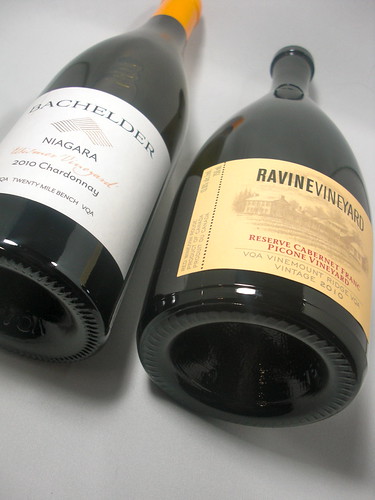
I both love and loath best-of wine lists. They are so frustrating to write and they never feel quite complete or fair to all the wines in the region being assessed.
I don’t come close to tasting every wine made in Niagara. I do my best, but with 75 wineries churning out thousands of wines every vintage it’s just not possible.
Even living here in Niagara, there are still dozens of wineries I haven’t even visited, either by design or just because I just haven’t got there yet.
So, my annual Top Wines of the Year list should be taken with a grain of salt. A big grain.
I arrive at this list by making notes throughout the year of the wines that had a profound effect on my tastebuds, the wines that were memorable and the wines that I think about long after I’ve tasted them.
From that list I come up with a red and white that was more memorable than all the others. These two wines are the ones I think about most, and aren’t necessarily the wines that scored the highest when I reviewed them. I know that sounds odd, but sometimes the memory of the wine grows on me or I re-taste it and it rises in stature in my mind.
The 2012 year in Niagara wine was amazing. It was the greatest year I can remember for top-quality reds and whites released, all driven by some key factors — most the reds were from superb vintages (the Bordeaux reds from 2010 and the Pinots from 2009) while the whites were spread over several vintages and were dominated by Chardonnay and Riesling.
Two classic varieties emerged as my Red and White Wines of the Year — the Ravine Cabernet Franc Picone Vineyard Reserve 2010 and the Bachelder Wismer Vineyard ‘Winfield Block’ Chardonnay 2010.
These were the two wines I craved the most long after I tasted them and reviewed them. I have re-tasted both wines and it only reinforced my choices.
Both are fine examples of two grapes that are shining stars in Niagara. Cabernet Franc may have its problems in cooler vintages like 2008 and 2009 but in a year such as 2010, the weedy-leafy-herby notes are relegated to the background to give rise to the wonderful fruit this wine can deliver. Bachelder’s Chardonnay, even in a ripe vintage such as 2010, is remarkable and a testament to one of Niagara’s best winemakers who knows exactly what to do with this grape in ripe or cooler vintages.
So, here’s my list. Agree or disagree, I welcome your comments.
The Top 10 Reds
Red Wine of the Year
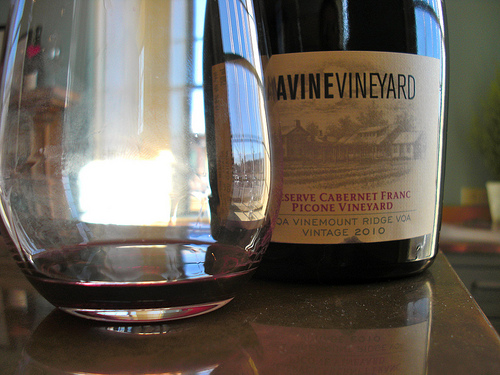
Ravine Cabernet Franc Picone Vineyard Reserve 2010 ($40, still a few bottles left at the winery, 92 points) — Only 160 cases of this Cab Franc from the Vinemount Ridge appellation were made. It’s a killer wine and a brilliant example of where this varietal can go in a ripe vintage when grown and made with care. The nose shows wonderful raspberry-cherry fruit, tobacco, plums, blueberry pie, violets and integrated spice notes. It shows wonderful balance in the mouth with the fruits well-integrated, fine tannins and an under-handed approach to the oak spices. Just a very fine, elegant Cab Franc that will absolutely wow you.
The rest of the Top 10 Reds
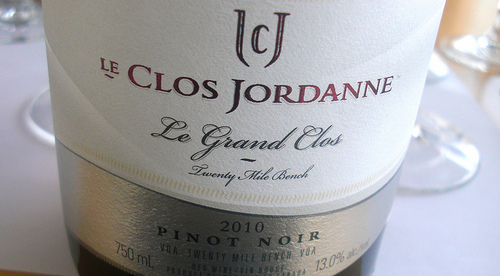
Le Clos Jordanne Le Grand Clos Pinot Noir 2010 ($70, available at the Jackson-Triggs winery, 94) — This is simply gorgeous and even tops the Pinots from the excellent 2009 vintage, in my opinion. It has it everything I love in great, cerebral Pinot Noirs. The nose shows savoury cherry, cranberry, currants, roasted garden herbs, sweet oak spices, vanilla toast, plums, raspberry and cassis all in perfect harmony. It is a wine with profound depth of flavour on the palate, running the gamut from bright red fruits to earthy, meaty and savoury dark fruits, violets, wet earth, chalky minerality, oak-inspired spices that are all intricately woven together on a seamless spine of silky tannins, acidity with both the power and grace that will carry this long into the future. It is one of the finest Le Clos made to date. And it has the stuffing to get even better with time.
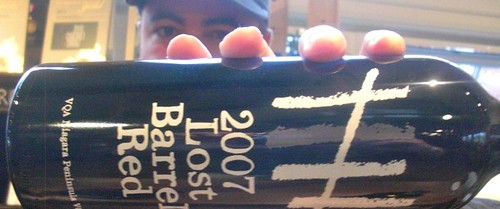
Creekside Lost Barrel Red 2007 ($65, winery, 93 points) — No one really knows the exact components (at least no one is saying), but it’s safe to say that Cabernet Sauvignon, Merlot, Cabernet Franc, Syrah, Malbec and Pinot Noir, yes, Pinot!, all play some sort of role in this glorious red blend. Only three barrels were produced. Fermenting is done in new oak barrels then is quickly moved to neutral French oak barrels for an incredible 3.5 years and forgotten about, because, afterall, it’s the “Lost Barrel.” In the glass it is thick and dark as the waves of plum puree, black currants, warm summer field raspberries, black peppercorns, mocha, toasted vanilla and licorice come at you. It’s a big bruiser on the palate with power and structure and layers of lavish spice that work in concert with a fruit bowl of flavours through an incredibly long finish. This is a collector’s wine and it would be a shame to buy and open it any time soon. Though, I wouldn’t turn down a bottle to go with a huge hunk of rare filet mignon wrapped in crispy bacon. Now we’re talking!
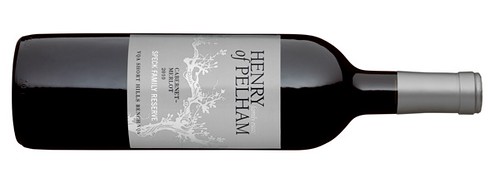
Henry of Pelham Speck Family Reserve Cab-Merlot 2010 ($50, winery, 93 points) — When I think of Henry of Pelham, this is the wine that immediately comes to mind. Anyone who believes Niagara can’t make big, ripe Bordeaux style reds should try this in the best vintages. It performs like it is a Bordeaux with such a beautiful transformation as it ages and sheds the tautness of youth. They are tightly wound on release and eventually come into beautiful harmony if you have the patience, which I suspect you do if you’re shelling out $50 for a top-drawer red. The wine spends 18 months in French oak and is a blend of Cabernet Sauvignon and Merlot. The nose shows a brilliant array of black cherry, blackberry and crushed currants with mocha, vanilla and oak spice. It is highly structured on the palate with intense fruit, scorched earth, firm tannins and lovely secondary flavours of chocolate and cassis. Wait for this to come into balance. History tells us that this will be a blockbuster with a few years to soften out in the cellar.
Hidden Bench Locust Lane Vineyard Pinot Noir 2009 ($55, winery, 93 points) — It is with this more feminine style where my tastebuds are happiest. Like a seasoned ballerina, it shows elegance and poise from the first whiff of black cherry, raspberry, currants, violets and forest floor. It dances nimbly on the palate, with balanced and evocative red and dark fruits that mingle nicely with the cedar, spice and beetroot nuances. This is the kind of stuff I look for in top Burgundian reds and it will only get better with age.
Tawse Estate Cherry Avenue Vineyard Pinot Noir 2009 ($58, winery, 93 points) — This is the flagship of the Pinots from Tawse and it shows with this smart wine from the fine 2009 vintage. Such a striking nose of perfumed fruit, foraged mushrooms, black cherry, red currants, blueberry and loam. It is wild and untethered on the palate, a complex and layered Pinot with a wonderful array of fleshy red fruits, poised oak spice and earthy minerals delivered on a bed of fine-grained tannins. It’s an intense wine through a long, lingering finish. Buy, hold and enjoy.
Rosewood Cabernet Franc Barrel #67 2010 ($32, winery, 93 points) — As the name implies, only one barrel, 20 cases, are available of this naturally fermented (30 days) beauty that was aged for 15 months in a Billon French oak barrel. There’s a whole lot of awesomeness going on in this benchmark Cab Franc. Gorgeous, ripe, bold and thick red fruits with the emphasis on raspberry and bramble, generously spiced, with dark chocolate, leather and cigar box cedar. The red and dark fruit flavours and wild spices are persistent on the palate and through the long, long finish. This is Cab Franc with attitude and power yet shows remarkable poise in the mouth. It is evolving and still and needs time but hard to resist this wonderful wine. A long life awaits this Cab Franc and a lot of pleasure awaits those who snag a bottle or two.
Fielding Estate Cab-Merlot 2010 ($35, not released until the spring, 92 points) — This was previously called Meritage and is a blend of Cabernet Franc (42%), Merlot (33%) and the rest Cab Sauv. What I am discovering with the 2010 red blends, compared to the last great vintage of 2007, they have more finesse and balance. The nose on this beauty shows cherry, cassis, blackberry, vanilla and toasty-oak nuances. There isn’t as much earth as 2007 as the fruit dominates the nose and palate. There are some savoury-smoky herbs in the mouth but they only play a supporting role to the rich, layered cassis and dark cherry flavours to go with ripe tannins and uplifting acidity through a long finish. Decant for a couple of hours upon release or hold for a few years in the cellar.

Malivoire Courtney Gamay 2010 ($30, winery, 92 points) — This top red from Malivoire, in a year such as 2010, is a beauty. Courtney has a cult following and many feel this is the best Gamay gets in Niagara. Winemaker Shiraz Mottiar puts this single-vineyard Gamay into all-French, tight-grained oak for 14 months and it shows on the nose with a riot of spices, including mocha, clove and cinnamon, emerging from the thick array of concentrated kirsch, raspberry, plum and cassis fruits. This is textured and showy on the palate with full-on creamy red fruits all bolstered up by lavish and wonderful spices that light up the mouth all the way through the long finish. Just a beautiful and expressive red.
Jackson-Triggs Grand Reserve Shiraz 2010 ($20, winery, LCBO, Wine Rack stores, 90 points) — There are a lot of things going for this wine, not the least of which is the price, which, in part, is the reason it bested other higher scoring wines to make this list. It has a dark, menacing (in a good way) colour in the glass. It shouts bold and flavourful and delivers on both accounts. It’s so Rhone-like on the nose with boysenberry, blueberry, black currants, roasted meats and white pepper aromas. It rocks on the palate with big meaty red fruits, roasted Espresso bean, game, layers of spices and firm tannins that will soften with a little time in the cellar. An excellent Syrah at an attractive price.
The Top 10 Whites
The White Wine of the Year

The Bachelder Wismer Vineyard ‘Winfield Block’ Chardonnay 2010 ($45, not released quite yet but available in some restaurants like Treadwell in Niagara, 94 points) — Wow! A stunner. Winemaker Thomas Bachelder calls the famed Wismer Vineyard on the Twenty Mile Bench a Grand Cru of Niagara. But Bachelder goes one better and sources his Chardonnay from a specific block from Wismer’s coveted vineyards. The wine took nearly a year to ferment, as Bachelder likes all his wines to ferment naturally in the cellar. It is a big, showy Chard that makes a statement from the first sniff. Poached pear, fresh-baked apple pie, waves of flint and stony minerality, and then the creamy vanilla spices, toffee and elegant oak that is integrated rather than over-powering chimes in. It is weighty on the palate with bold fruit matching rich and toasty spices and balanced out by racy acidity. It’s a powerful and stylish Chard with hedonistic flavours that all lead to a gloriously long finish. Bravo!
The rest of the Top 10 Whites
 Hidden Bench Roman’s Block Riesling Rosomel Vineyard 2010 ($30, winery, 93 points) — Such a beauty, and a must-have wine for the serious collector of Niagara Riesling. The old vines deliver a complex and intricate bouquet of peach, lime blossom, apple and limestone. It is quite rich and bold on the palate with ripe fruits, beeswax, lanolin, lemon-honey, summer peach and even a touch of white pepper all delivered on a long, lush finish. Such a wonderful Riesling that will age nicely for five years or more.
Hidden Bench Roman’s Block Riesling Rosomel Vineyard 2010 ($30, winery, 93 points) — Such a beauty, and a must-have wine for the serious collector of Niagara Riesling. The old vines deliver a complex and intricate bouquet of peach, lime blossom, apple and limestone. It is quite rich and bold on the palate with ripe fruits, beeswax, lanolin, lemon-honey, summer peach and even a touch of white pepper all delivered on a long, lush finish. Such a wonderful Riesling that will age nicely for five years or more.
Hidden Bench Tete de Cuvee Chardonnay 2009 ($45, winery, 93 points) — The 2008 version of this top Chardonnay, sourced from the best barrels from Felseck and Rosomel vineyards, was my white wine of the year in 2011 and the 2009 vintage follows closely in those footsteps. Tete de Cuvee is such a complex and contemplative wine. It makes you think and challenges your senses with the evolving nuances that change constantly in the glass. “A wine drinker’s Chardonnay,” said Hidden Bench owner Harald Thiel. For me, it’s exactly what I look for in a good wine; complexity, balance, integration of flavours and a finish that lasts for minutes. This is a young wine and quite tight on the nose, however, the baked apple, brioche and elegant oak stylings are beginning to emerge and rise above the stony bed of minerality. It is chock full of creamy-toasty pear-apple fruit and roasted hazelnuts on the palate. A minute later there’s a shot of citrus zest chiming in. All of those swirling flavours are bolstered by fine oak spice and lifted by a vein of acidity that brings balance to the package. For deep thinkers and those who like to be challenged by their wine.
Tawse Estate Robyn’s Block Chardonnay 2010 ($46, winery only, 93 points) — Organic and bio certified, this is a tour de force and a shining beacon for terroir-driven Chardonnay in Niagara. It’s fresh and clean on the nose with a stream of minerality, soft green apple, lemon-citrus zest and such elegant spices in the background. On the palate, oh my! An opulent, vivacious wine with tremendous quince, toffee-oak spices and mineral flavours that are persistent yet beautifully elegant and build in intensity in the mouth. It’s lavish and weighty but lifted by firm acidity through a long, long finish.
 Thirty Bench Small Lot Steel Post Vineyard Riesling 2011 ($30, winery, 93 points) — I am always drawn and seduced by this Riesling. It is one of my favourite wines every year. I was blown away by its charms in 2010 (94 points) and find myself enthralled with the 2011 version. I think this will evolve into a finer wine than the 2010, with greater cellaring potential. It is open-ended on the nose with gushing lime, grapefruit, hints of peach and apple and the most interesting minerals of the three. This is heady and complex on the palate, a structured Riesling with concentrated lime-citrus, steely acidity, an interesting yet subtle white pepper note and a mouthful of minerals that carry through the finish. This has it all: Power, length and balance and will reward for years down the road.
Thirty Bench Small Lot Steel Post Vineyard Riesling 2011 ($30, winery, 93 points) — I am always drawn and seduced by this Riesling. It is one of my favourite wines every year. I was blown away by its charms in 2010 (94 points) and find myself enthralled with the 2011 version. I think this will evolve into a finer wine than the 2010, with greater cellaring potential. It is open-ended on the nose with gushing lime, grapefruit, hints of peach and apple and the most interesting minerals of the three. This is heady and complex on the palate, a structured Riesling with concentrated lime-citrus, steely acidity, an interesting yet subtle white pepper note and a mouthful of minerals that carry through the finish. This has it all: Power, length and balance and will reward for years down the road.
Stratus Chardonnay 2009 ($55, winery, 93 points) — A classic Chardonnay that stands among the best in Niagara including Hidden Bench Tete de Cuvee, Les Clos Jordanne, Tawse Quarry Road, and Southbrook Poetica. It was made in a true 50-50 collaboration between J.L. Groux and Paul Hobbs, all initiated in the winery, not the vineyard. Hobbs’s 50% included wild yeast fermentation and whole bunch pressing while Groux’s 50% included short skin contact, controlled yeasts and no whole bunch pressing. They found common ground in the oak — 100% French (part new, part older barrels) and 100% malo. The grapes for this cuvee were picked in November from vineyards planted in 1985 and cropped to two tonnes an acre (the lowest yield ever for this grape at Stratus). My, what a Chardonnay! A nose of brioche, pear, spiced apple and a riverbed of minerality. It is simply electrifying on the palate with golden apple, pineapple, pear and shaved citrus zest all wrapped up in an elegant, structured package that suggests a long life. The spices are integrated and nuanced with a bead of minerality running through the racy core of this gorgeous wine.
Southbrook Poetica Chardonnay 2009 ($50, winery now, 93 points) — The flagship white from Southbrook and it lives up to its lofty place on the hierarchy. Such a beautiful Chardonnay and easily one of the top three made in Niagara. Winemaker Ann Sperling says the winemaking “adheres to the traditional model of Burgundy” and more specifically the Chards of Meursault. The grapes for this wine were whole cluster pressed and the settled juice racked to barrel where indigenous yeast and malolactic bacteria fermented the juice. After 10 months of aging the top selection of barrels were combined to make the Poetica. The complex nose shows apple-pear-pineapple fruit, brioche, gun flint, mineral, and vanilla cream. This is exciting stuff on the palate with lush fruits delivered on a spine of racy acidity. It shows elegance and power with weight in the mouth to go with ripe apple-pear fruit, a touch of butterscotch cream and a vein of minerality that runs through the core. This, like most the Poetica Chards, has the stuffing to mature gracefully for many years down the road.

Flat Rock Cellars Riesling Reserve 2009 ($30, winery, 92 points) — This remarkable reserve Riesling from Flat Rock is sourced from a small lot within the estate vineyards. This is the first vintage for the new “red label” reserve wines. The wine uses a mix of wild and cultured yeasts and went through partial malolactic fermentation. It’s a weighty, powerful Riesling done in the Alsatian style with vibrant citrus, developing petrol notes and wet stone minerality. It’s complex, bold and has wonderful length on the finish. A real treat that will develop beautifully in the cellar for 10 years or more.
13th Street Sandstone Reserve Chardonnay 2011 ($35, winery, 92 points) — Now, this is something. It was just bottled when I tried it, and is being released in time for Christmas with a classy new label. A warm, inviting nose of swirling spicy-creamy goodness that combines baked apple, poached pear, stony minerals and just a touch of citrus. Beautifully elegant and finessed on the palate and already showing fine balance between ripe fruit, cream, spice and acid. It’s lovely now but will be better on release in December and after a few years in the cellar.
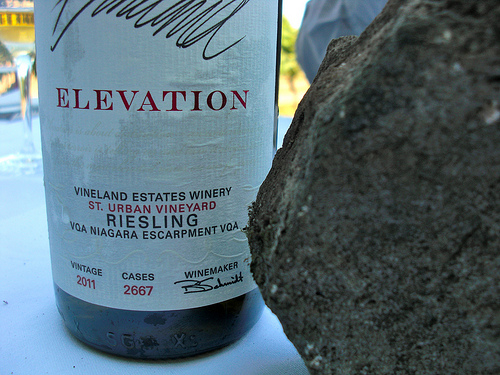
Vineland Estates Elevation St. Urban Vineyard Riesling 2011 ($20, winery, 92 points) — Beginning with this vintage, Vineland has merged the St. Urban and Elevation Rieslings into one. This is classic Niagara and a superb example of Bench Riesling with notes of grapefruit-citrus, white peach and river-fresh minerality on the nose. It’s a Riesling that gets your full attention in the mouth with all that citrus-y-peach goodness on the palate, racy acidity and a classic tug of sweet and tart. There is underlying minerality that will express itself further as you age this beauty. And, yes, you can age it for five, or even 10, years.
For another great list of top Niagara and Ontario wines, visit Shawn McCormick’s excellent blog Uncork Ontario for his picks.


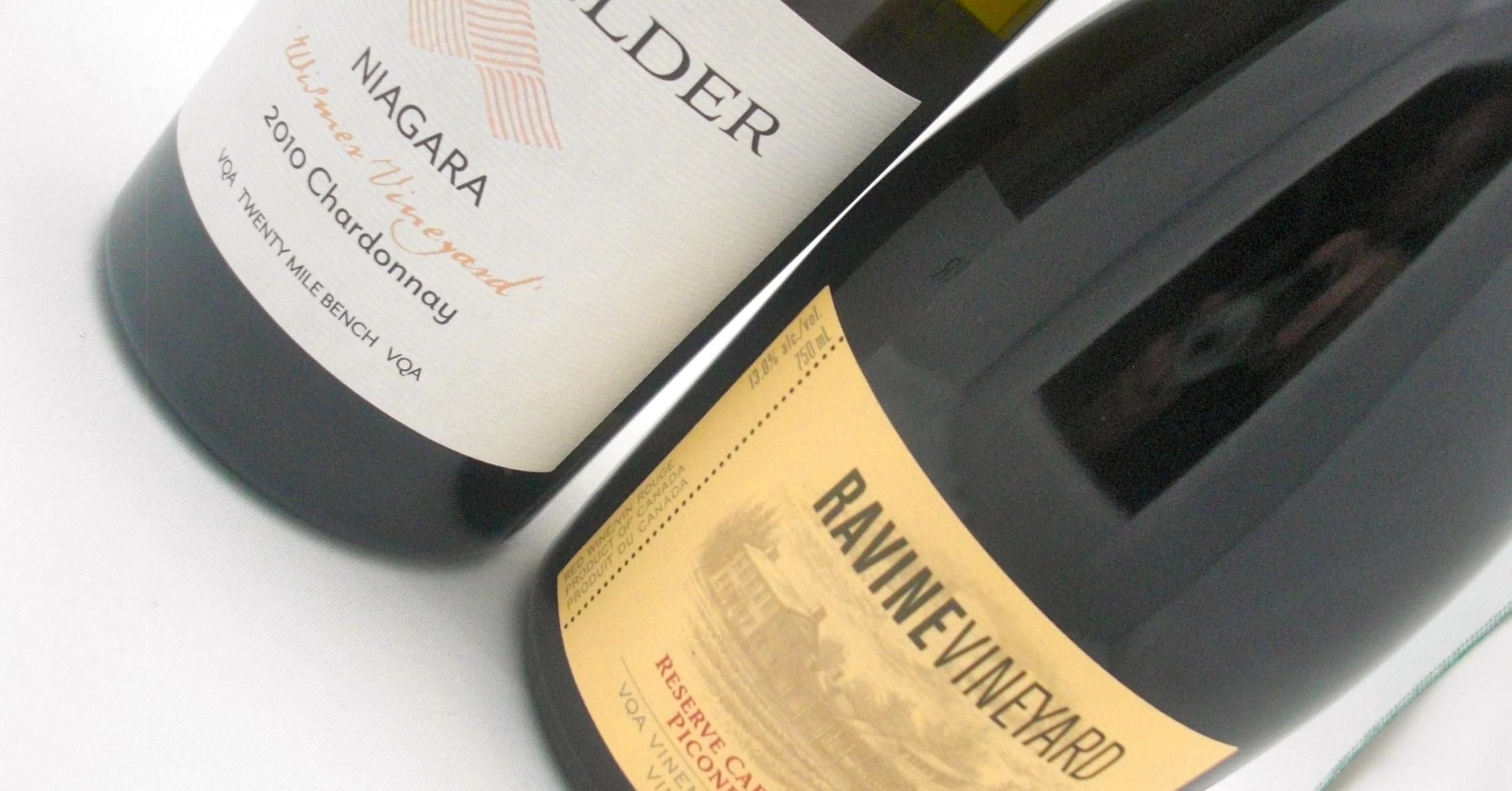



Felt the same way about the Piccone Cab Franc. Took a single sip from the sample they poured, then immediately turned around and picked a bottle of the shelf. Sometimes they just grab you.
And if you put that Bachelder Wismer ahead of the Tete de Cuvee, then I REALLY have to find me some! :)
Dan, I think some restaurants are pouring the Wismer now. I will try and find which ones (I know Treadwell has it by the glass here in Niagara). Bachelder (as a virtual) can only sell through the LCBO (as you know) so he is at the whim of the LCBO to release the wine. And, by the way, it was a very tough call between Bachelder and Tete de cuvee.
I’m not sure if your top 10 list caused this but we stopped by J-T on the weekend to get some of the 2010 Grand Reserve Shiraz at they were all sold out. 144 bottles were sold in one day. They have to get more from the warehouse. It’s a great wine for the price.
Fred, Very true, a great wine and a bonus that it’s affordable. That and the Vineland Riesling were the two bargains on the list.